Arkeocean’s Inca & Maya anti-sub warfare UUVs
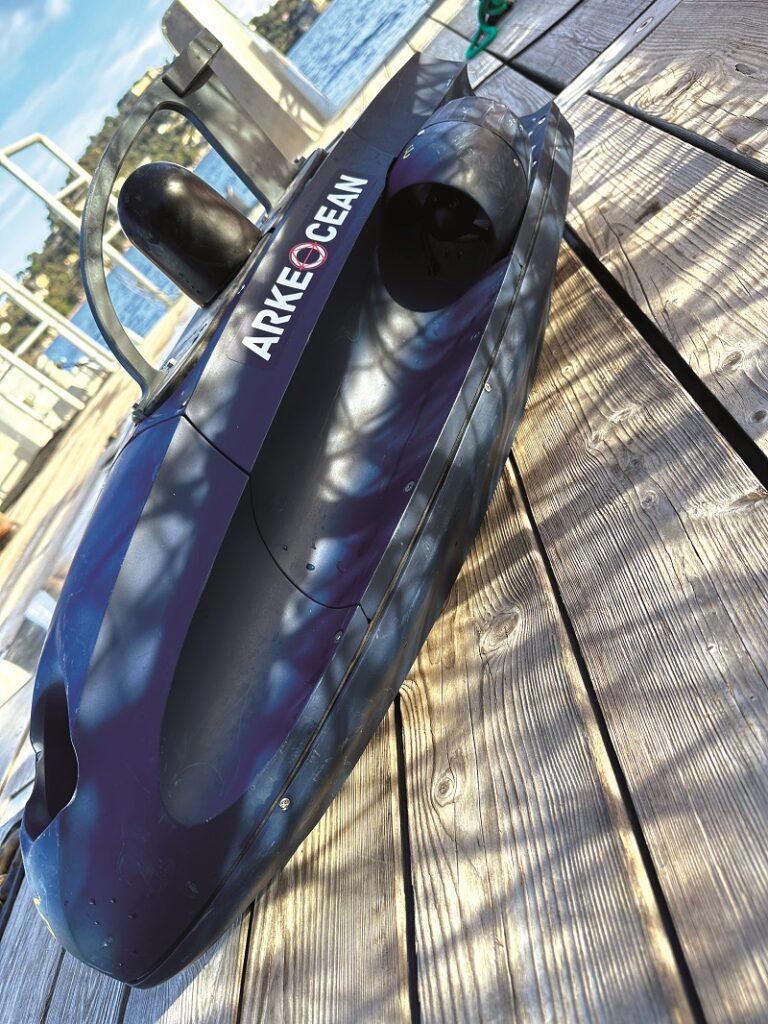
Rory Jackson reports on a firm using a group of autonomous micro-AUVs to hunt and find hostile submarines
Of all the different types of military mission being tackled today by uncrewed systems, anti-submarine warfare (ASW) is arguably the most complex. To detect and help defend against some of the stealthiest and most dangerous vehicles on Earth, navies are increasingly leveraging a broad array of highly advanced autonomous systems across air and sea.
Diesel-electric submarines in particular are extremely silent and hence difficult to detect compared with nuclear submarines, and although the former would traditionally have to surface every few days to take in air, hybrid and electric powertrains for submarines are becoming more efficient.
There is increasing availability of air-independent hydrogen-fuel cell powertrains, such as those made by Infinity Fuel Cell (Issue 47, December 2022/January 2023) or used by Cellula Robotics in its long-endurance, extra-large uncrewed underwater vehicles (XLUUVs) (Issue 30, February/March 2020). This is enabling submarines to travel silently underwater for extended periods of time and power longer-distance sensors for 3D-modelling subsea targets up to 1000 km away at very high fidelity.
Such distances make detecting targets even harder, so submarine crews will find it increasingly easy to spy on and eventually attack foreign assets with impunity unless someone can engineer a new type of subsea passive antenna capable of detecting them.
Such an antenna would need to pick up ultra-low frequency (ULF) signals of 0-100 Hz, as the lower the signal’s frequency, the further it propagates (resolving the issue of distance by detecting the lower part of submarines’ noise spectrum). To overcome the painfully low volume of such noise, the antenna would need to be massive: picture the size of antennas presently used by astronomers to study celestial phenomena across the galaxy and you’ll have an idea of the scale needed.
So, how does one build such a huge antenna, and still cover the vast swathes and different directions of ocean across which hostile submarines may hide without utterly draining their defence budget? The answer, says Thierry Brizard, president and co-founder of Arkeocean, is to create a swarm of autonomous micro-AUVs, which, through their collective hydrophones, form a giant sparse antenna for detecting submarines below the waves.
“By building our AUVs and forming swarms of ULF-detecting underwater nodes with them, we’ve already created antennas as large as 400 m by 100 m, and in terms of the laws of physics, there’s nothing stopping us making antennas of maybe dozens of kilometres in size,” says Brizard, who previously served as a CTO across several Thales Group companies, particularly in its underwater defence solutions.
ASW on such a scale has not been achieved before, nor attempted with micro-AUVs. Historically, the biggest passive antennas for submarine detection have been towed arrays, consisting of singular wires of a few kilometres long (although certain geophysics applications have made use of towed arrays up to 10 km long). ASW commanders, however, have criticised towed arrays for producing very ambiguous data, and the cables comprising most of their length are extremely vulnerable to being damaged or cut off.
“A mechanical antenna would have similar structural weakness in that damage to one part of it could easily render the whole thing inoperable, but a swarm has no structure,” Brizard says. “We autonomously and accurately maintain a formation of small AUVs in the water, [with] that formation ensuring the effective and precise functioning of the antenna, and thus the detection of submarines and anything else radiating or emitting ULF signals below the waves.”
The road to Proteus
Arkeocean was co-founded in 2009, by Brizard and his daughter, Tamara, with the latter serving as managing director until 2023, when she transitioned to a new role as president of Keo Robotics, partner company to Arkeocean, on some key technical developments.
Until 2019, Arkeocean focused on developing subsea technologies for divers and other aquatic applications, but during that year it joined Aramco’s SpiceRack programme, aimed at using an AUV swarm to perform seismic surveys at 30-40% of the cost of usual approaches. As a subcontractor, Arkeocean was tasked with providing and integrating the C2 (command and control) systems, including acoustic devices for the AUVs (built by another partner), and testing them off the coast of France.
This not only brought great tangible experience to the company in engineering high-end swarming AUVs, but also alerted them to the impact that such swarms could have across energy, defence, marine research and elsewhere. So, Arkeocean began working on swarming micro-AUVs of its own, and it started getting contracts for trials and models, including some for the Direction Générale de l’Armement (DGA), the French defence procurement agency, as well as involvement in the French Navy Orion exercise in 2023, which garnered notable recognition.
Inca and Maya
Through these projects, Arkeocean has developed a few modes of swarm applications, with its Proteus solution being potentially the most comprehensive and complete approach to ASW. Proteus is a swarm operation using multiple units of micro-AUVs, specifically Arkeocean’s Inca and Maya vehicles. The exact number scales with the size of the sparse antenna and the swath of ASW coverage desired, and micro-AUV design plays a distinctly different role in the Proteus operating model, as Brizard explained.
Inca and Maya are designed to hover, station-keep and loiter, with minimal operating costs to form a cost-effective, persistent passive antenna. Both AUVs look distinctly different from the maritime industry’s traditional, torpedo-type AUVs, with their long, thin bodies and singular propeller screws, which cannot hover or hold position effectively.
“Plus, in the near future, industry regulations are going to come out that require AUVs longer than 1 m to be registered, along with other compliance needs. All our AUVs are less than 1 m in length, so we will avoid such constraints,” Brizard says.
The Inca is 70 cm in length, with a thick body (slightly similar in shape to a shark), and it weighs 16 kg in air. It is typically engineered to be neutrally buoyant – except in some niche applications where it is made negatively buoyant to sink down to the seafloor (with some altered navigation firmware to account for the change in weight) – and remain stationary there to form a surveillance barrier on the seabed.
It is designed with two pairs of thrusters: two vertically oriented in tunnels along the Inca’s hull length, one near the nose and one behind an antenna fin, with the other two being ducted and mounted near the back, one on the left and one on the right.
The vertical thrusters enable the Inca to hover and maintain a particular altitude in the water, while the horizontal thrusters can hold a given horizontal position; differential thrust between the horizontal thrusters enables turning with zero radius to compensate for currents running sideways to the direction the Incas face.
“We have worked especially hard to keep them as low-cost as possible. Our end-users may need dozens of Incas to form their swarm, so Proteus absolutely would not work if each unit cost $2 million to $3 million, like long-endurance work-class AUVs do,” Brizard adds.
“The Incas don’t leave the water: they need to hold position and keep surveying, or else they would create a gap in the antenna swath. So, as you can’t use radio underwater nor acoustic modems for detailed data transfer, we need a second AUV to ‘mule’ the data from the Incas to the navy crews surface-side.”
Maya uses a similar thruster configuration to Inca, with two vertical and two horizontal propellers, but otherwise it is physically quite different. Maya has a rounded, almost disc-like frame body, with its hydrodynamics optimised for thrusting up and down (while the Inca is designed for thrusting forwards and backwards to hold position against currents).
Maya integrates an RF antenna, extending vertically upwards from its top side, as well as a RTK-GNSS antenna, and at its lower side there is a SEAKER, which is a very small Arkeocean ultra short baseline (USBL) for automatically docking with the Inca and collecting its survey data. The SEAKER plays a critical role in the operation that follows.
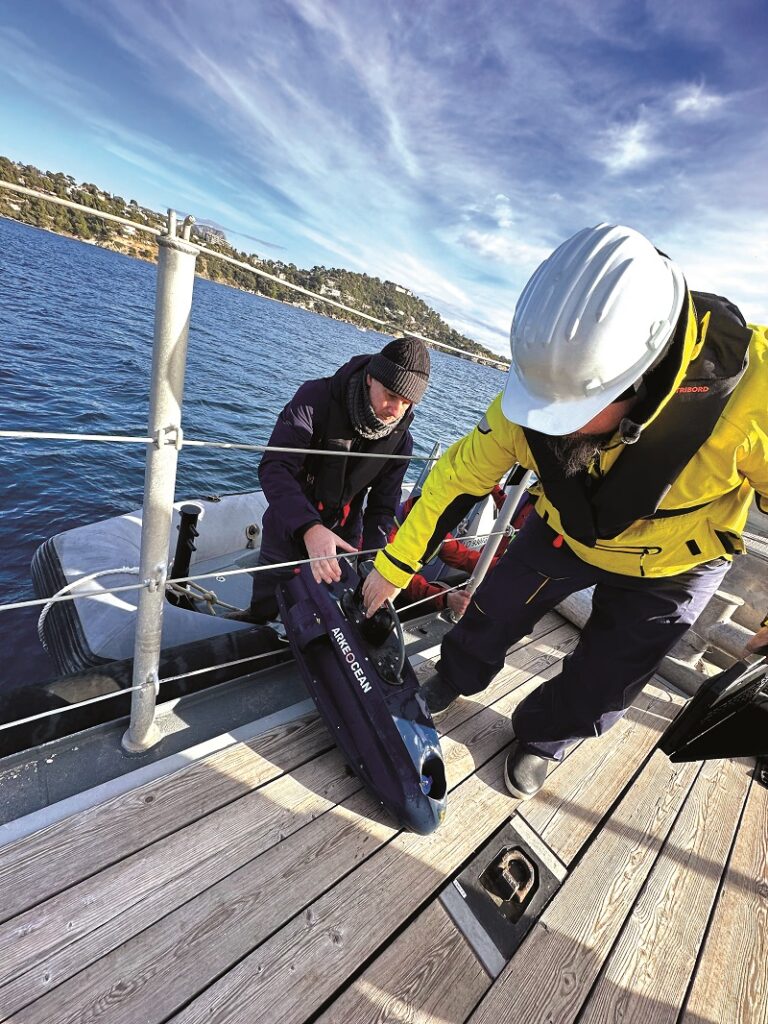
On deck
First, the Incas and Mayas must be transported to the ASW survey location by a support vessel. Before lowering them into the water, which can be done by simply dropping them in by hand, some pre-launch steps must take place onboard.
All AUVs have a wi-fi connection, so the operators at the ship’s command and control centre can interface with the Mayas and Incas remotely.
“The AUVs must be powered-on so that the C2 officers can affirm that their vital systems are functioning and then engage with the mission planning. The plans can be uploaded to the AUVs wirelessly,” Brizard explains.
The planning software has been developed in-house, with particular elements focusing on the 2D or 3D shape that the swarm formation may take. Key tools used in its development from early on were C++ and Qt libraries common among programmers, although today, Arkeocean increasingly uses web-based application environments for creating its C2 software. The company will also integrate COTS software applications for key functions, such as displaying tactical information in formats familiar to some naval users when requested.
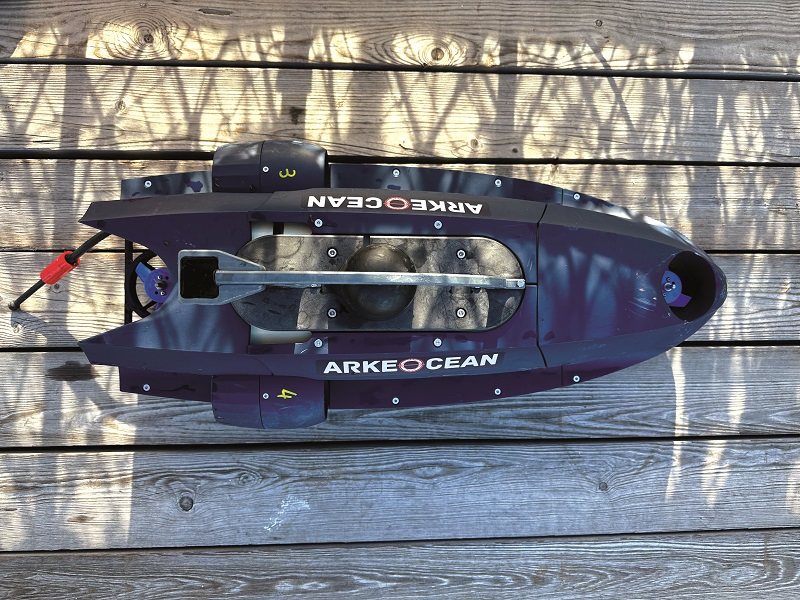
Swarm overview
Industry literature specifies a variety of different swarm types, with varying permutations of command, control and communication (C3) orderings and hierarchies, as well as different degrees of autonomy within individual uncrewed systems and across the group.
Arkeocean’s swarm has a distinctly top-down structure: the Incas do not communicate with each other, as installing an acoustic modem would have taken up the limited internal space and production costs per unit (with little benefit in terms of actual data bandwidth).
“The C2 centre is at the top of the swarm control structure, and there, via the Mayas, we receive the survey data and the time of arrival (TOA) of the positioning signals emitted by each Inca, and then transmit any position adjustment commands to the Mayas, who then communicate those commands to the Incas,” Brizard says.
To do this, the Mayas travel vertically up and down from the surface to the Incas, thrusting up to the surface to communicate with the C2 centre using their wi-fi and then returning to the next Inca afterwards.
This is key to the effectiveness of the antennas. The Incas do not actually engage in constant position-holding while actively listening for submarines as this would mean constantly spinning up their thrusters and muffling potential ULF noise. Instead, they drift for much of the time, thereby increasing the signal-to-noise ratio of their ULF recordings.
Total endurance figures have not been determined as yet, being highly dependent on currents during operations. Arkeocean continually collects data during its deployments to gauge the suitability of its battery packs for the CONOPS, although it anticipates needing to increase the capacity of the packs on its micro-AUVs in future versions.
Drifting for too long obviously risks dispersing the Incas, and hence harming the antenna’s integrity. So, based on position adjustment commands delivered by the Mayas, the Incas will very occasionally activate their thrusters to maintain the geometry of the antenna, which may be a vertical line in the water column or a grid.
In most cases so far, Proteus has been trialled as a ‘2D vertical antenna’, with a flat, vertical panel of Incas running down through the water, thereby operating similarly to an air traffic surveillance radar, although Arkeocean notes that antennas with 3D shapes are possible too.
“In terms of the number of AUVs per operation, the nodes in the antenna sampling for ULF readings should be spaced apart at half the wavelength of the higher end of the band,” Brizard says.
“As the higher end of ULF is 100 Hz, and the wavelength at that frequency is 15 m, half of that is 7.5 m. Hence, we would theoretically need an Inca AUV every 7.5 m, but if you want an antenna several kilometres long or wide, you will need a lot of AUVs to do it this way.
“So, we borrow a trick from the radar world; that is, we form what’s called a sparse antenna. By intelligently reducing the number of receiving nodes in the antenna and using some estimation algorithms to compensate, we can maintain an acceptable performance as a fully populated antenna with a fraction of the AUVs needed.”
Long baseline from surface
Theoretically, embedding AI software in the Incas could have enabled the swarm to self-adjust, communicating with one another via acoustic modems to localise, based on each other’s positions, correct themselves for current-caused drift, and reactively change their collective geometry in response to submarines or other detected threats. However, the amount of processing power needed for such software would have driven up the cost of each unit prohibitively (as would the integration of acoustic modems on each one).
Instead, real-time and accurate localisation of the Incas is performed by using the Mayas as long baseline (LBL) beacons. As our readers in the maritime industry will know, LBL networks typically work through seafloor-installed, acoustic positioning transceivers, which enable localisation of UUVs and divers accurate to around 1 m.
As with traditional LBL, the Inca AUVs can be localised as long as at least three Mayas are on the surface to form a perimeter around the antenna, although four Mayas is a better number for improving the Incas’ positioning accuracy. From there, they work via multilateration using the times-of-flight between the signals between the LBL beacons and the AUVs’ transponders, with the difference between the four times-of-flight (assuming four beacons) and each AUV being key to triangulating that AUV’s position.
“The Mayas are first deployed in the water to form a long baseline on the surface in which each Maya’s position is accurately known, thanks to their RTK-GNSS satellite receiver,” Brizard says.
After being launched into the water, the Incas broadcast acoustic positioning signals that are captured by the Mayas. Each Maya transfers the time of arrival (ToA) of the positioning signals to the C2 centre, which computes the position of the Incas by reference to the Maya’s LBL.
Then, to allow the Incas to form the predefined, passive sonar antenna grid, the C2 centre sends to each Inca (via the Mayas) a position adjustment command, which is executed by the Incas to reach and hold their position in the antenna grid.
“Traditional LBL beacons go on the seafloor, simply because that’s how you would fix their locations in place, but it takes great time and work to install those on the seafloor and then triangulate their GNSS position so you can localise your UUVs – and then, if the UUVs need to move somewhere outside of the spread of beacons, you have to move your beacons and go through the whole arduous process again,” Brizard says.
“The only reason people hadn’t thought to put LBL beacons on the surface before was because they’d move around, and so you couldn’t quite get their position accurately enough. GNSS would only localise the beacons to several metres, but now, by equipping LBL systems and new RTK-GNSS and DGNSS systems onto a single node, we can have the beacons float on the surface and still locate them accurately.”
Hence, as long as the Mayas are on the surface, they maintain a RTK-GNSS fix to 2 cm horizontal position (4 cm vertical), which, combined with the LBL positions of the Incas below, means the C2 centre can receive position updates for every AUV constantly, with the Incas being localised in real time to around 1.5 m accuracy.
“This isn’t some secret technology we’ve invented all by ourselves. In fact, approaches like this are rapidly becoming very popular for underwater localisation, especially as RTK corrections have become more and more affordable over the past few years,” Brizard notes.
The Mayas return to their Incas through guidance from the proprietary SEAKER USBL, composed of a directional receiving (Rx) phased array, which gives the relative bearing of incident acoustic signals, and a transmitter (Tx) used for the emission of acoustic positioning signals.
The SEAKER on each Inca codes its vehicle’s heading using time-shift keying at each acoustic transmission, which the Maya then receives and decodes to easily align itself with the Inca for mechanically docking with it.
After docking, the Mayas download the survey data (with each Maya using a very short-distance wi-fi connection to its Inca) and transmit it to the C2 centre via wi-fi after surfacing, doubling as LBL beacons during their upload time on the surface.
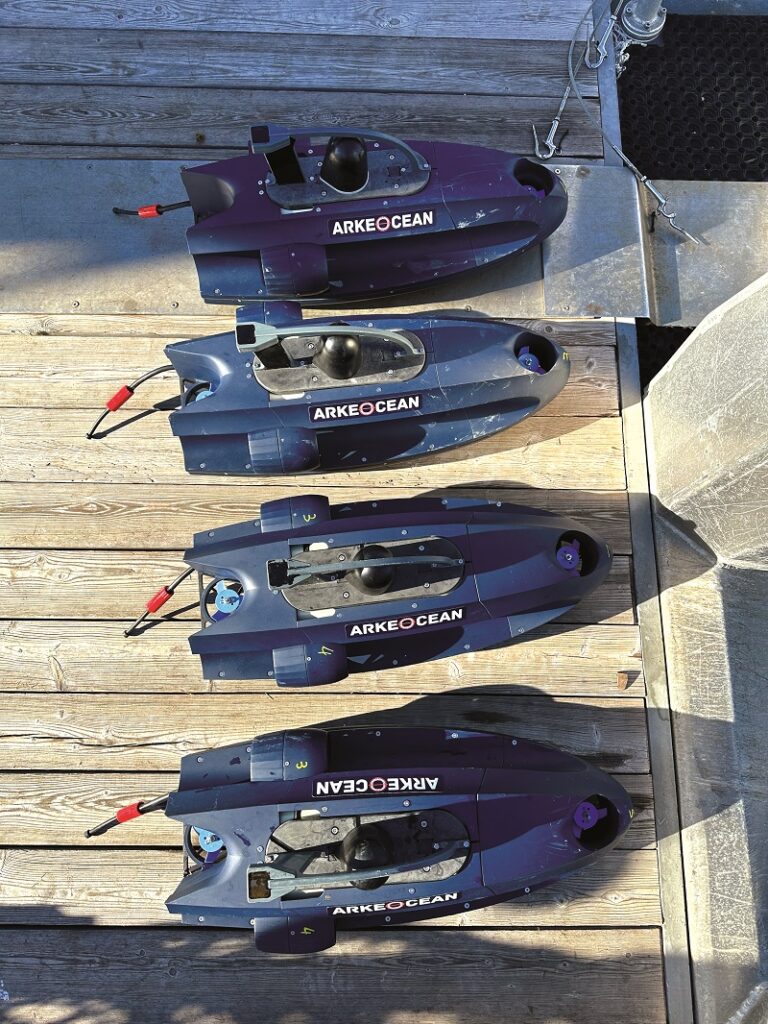
Beamforming
The ability to localise the Incas with 1.5 m accuracy is a critical part of the use-case. To carry out beamforming (a method that enhances the signal-to-noise ratio, mitigates interference and achieves very efficient antenna gain) the position of the antenna’s receiving nodes must be accurate in metres to one-tenth of the wavelength of the higher end of the band in hertz.
“As we have a 15 m wavelength for the 100 Hz end of the ULF band, keeping the nodes positioned to 1.5 m accuracy ensures the swarming antenna can do beamforming,” Brizard explains.
The Mayas transfer each Inca’s data to the C2 centre about once per hour on average, through which the C2 centre can perform sonar processing and beamforming. Following that, the detection, localisation and in some cases even classification of remote threats can be carried out.
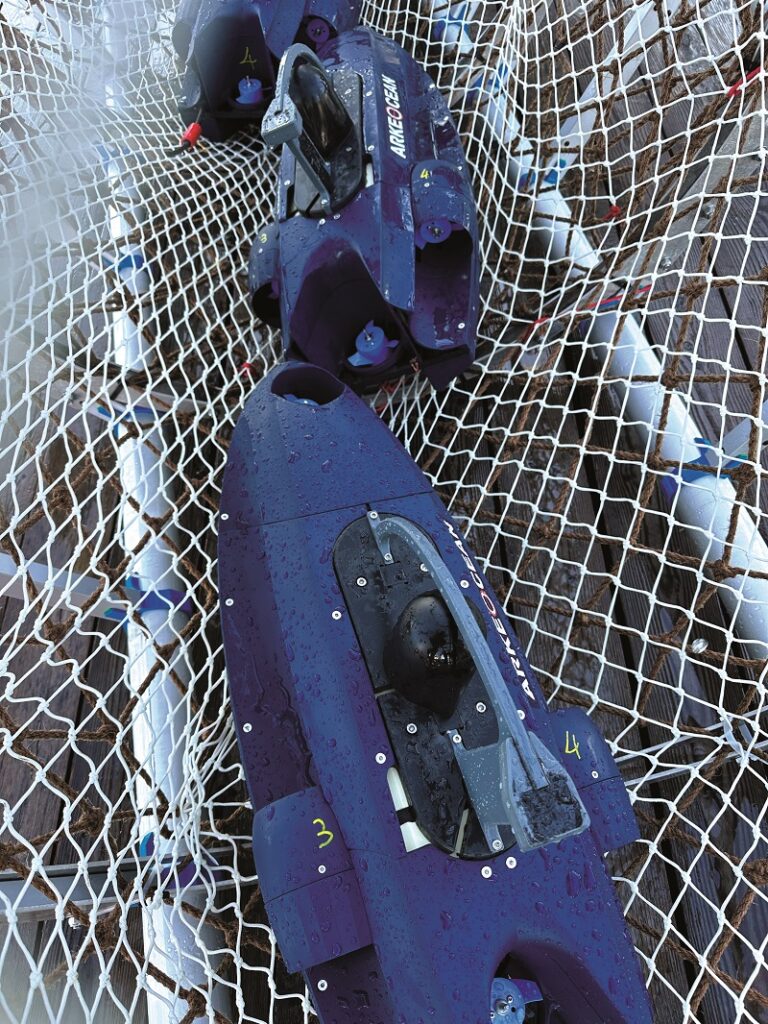
Post-mission
Recovery of all the AUVs at the end of their mission is rapidly performed via a large, metal basket, lowered by crane into the water, with an acoustic beacon whose signal the Incas and Mayas can detect. This signal activates an automated homing function, compelling the micro-AUVs to swim into the basket.
Once the crew topside are confident that the AUVs have all returned, they can raise the basket and lift then all onto the deck.
“The first thing we do after recovering the AUVs is quality control of the survey data. Each Inca carries a ULF recorder, which compiles all telemetry over the course of its mission to exact fidelity, which is important, not only to account for inertial drift but also in the event that some data could have been corrupted while uploading from an Inca to a Maya, or from a Maya to the C2 centre,” Brizard says.
“So, the recorder ensures data redundancy, such that we can ‘repair’ any flaws and faults within. After working for Thales, I spent some time in geophysics, and in that industry there’s only one thing geophysicists care about: the quality of the survey data and ensuring the beamforming will provide the required antenna gain to ascertain and analyse the number and type of submarine, or other remote subsea threats that were detected.”
Future targets
Arkeocean is continuing to optimise and modify its AUVs for different operational models, including versions that will leverage loitering modes for Incas in the column of water or sitting on the seafloor at low power for long periods of time. In both cases, they will surface for data transfer upon detecting a threat. This is currently being explored through the company’s LELANTOS solution, tested at sea by the French Navy.
Additional areas of interest include acoustic modems for UUV-to-UUV communications in real time, as well as the means by which AI behaviours can be installed in the micro-AUVs (particularly for functions such as real-time identification of complex acoustic signatures and enhancing detection probabilities) without driving up their cost and consuming their energy stores inordinately fast.
Arkeocean aims to manufacture and deliver 25 AUVs by the end of Q1 2024, with further plans to ramp up production to several hundred units by the end of 2025, with its customers largely composed of defence organisations that cannot be publicly disclosed as of writing.
To achieve these targets, Arkeocean is focused on hiring new engineers and other team members for its facilities in Brittany, both to increase manufacturing throughput and to design its next-generation swarming vehicles. One of these is a AUV larger than Maya and Inca, which will be capable of operating down to 3000 m below the ocean surface.
Key specifications
Inca
- Micro-AUV
- Length: 800 mm
- Weight in air: 17 kg
- Maximum speed: 5 knots
- Maximum operating depth: 300 m
- Maximum range (at 3 knots): 20 km
- Battery energy: 600 Wh
Maya
- Micro-AUV
- Dimensions: 570 x 370 x 370 mm
- Weight in air: 8 kg
- Maximum speed: 3 knots
- Maximum operating depth: 300 m
- Communication modes: 433 MHz, 2.4 GHz, 4G, Iridium (18 MHz optional)
Some key suppliers:
- Thrusters: Blue Robotics
- ESCs: Aikon Electronics
- IMUs: SBG Systems
- DVLs: Water Linked
- Argos native positioning beacons: Kinéis
- Satcom modems: Iridium
UPCOMING EVENTS























